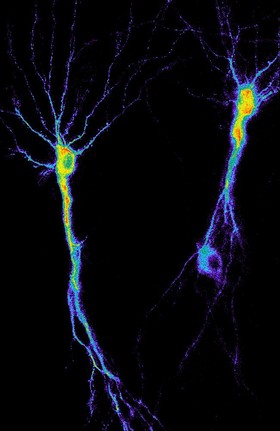Aberrant Tau Proteins Put Neuronal Networks to Sleep

The current study shows that Tau aggregates attenuate neuronal activity. In the above image two neurons are depicted. Image: DZNE/Frank Dennissen
In a study published in the journal PNAS scientists of the German Center for Neurodegenerative Diseases (DZNE) present new findings on the role of the protein Tau in certain brain diseases. Their report which is based on laboratory studies suggests that the drug “Rolofylline” could possibly alleviate learning and memory problems associated with aggregating Tau proteins.
The brain could easily be compared to the internet. In both networks information is transmitted from one unit to the next with numerous units making up the network. Unlike computers, neurons are interconnected by axons, thin biological wires which can be as long as one meter.
A protein called Tau normally helps in maintaining axonal integrity by stabilizing the tracks which are necessary to transport cellular components within the axon. However, Tau goes astray in multiple neurodegenerative diseases like Alzheimer’s and other “tauopathies”. Here it starts to aggregate into tiny fibers or clumps, which can corrupt neuronal function. However, the underlying mechanisms are poorly understood and there is therefore no effective treatment.
Now, researchers at the DZNE and the caesar research center led by Eva-Maria and Eckhard Mandelkow shed new light on the pathological processes that involve Tau proteins. As they report in the “Proceedings of the National Academy of Sciences of the USA” (PNAS), under pathological conditions, small aggregates of Tau accumulate in the axons. As a result, neuronal activity is attenuated but neurons do not die and do not seem to be seriously ill.
The aggregates only let neurons, so to say, doze off. However, the researchers also found a potential antidote: A drug called “Rolofylline”. It re-establishes neuronal activity despite of the production of pathological Tau. Rolofylline works by enhancing signal transmission and reception which strengthens the communication between nerve cells. Consequently, Rolofylline alleviates learning and memory deficits in mice that express the aberrant Tau protein, as the scientists have revealed.
Rolofylline was originally devised to treat renal dysfunction in human heart failure patients. The drug binds to a subset of cellular sensors called “adenosine A1 receptors”. Thereby, signal pathways are blocked, that otherwise would down-regulate neuronal network activity. Patients with neurodegenerative diseases might benefit from this. “Our results suggest that Rolofylline could potentially be useful to treat neuronal dysfunctions that occur in tauopathies. This makes the drug a hot candidate for further studies.
As an analogy, the Tau aggregates resemble a concrete wall in the middle of the room which blocks a WiFi signal. Rolofylline seems to work as a WiFi booster that can re-establish the connection despite of the obstruction”, says Frank Dennissen, a member of the Mandelkow Lab and first author of the current paper.
Original publication
“Adenosine A1 receptor antagonist rolofylline alleviates axonopathy caused by human Tau ΔK280”, Frank J. A. Dennissen, Marta Anglada-Huguet, Astrid Sydow, Eckhard Mandelkow and Eva-Maria Mandelkow, PNAS (2016), DOI: 10.1073/pnas.1603119113
Media Relations
Dr. Marcus Neitzert
DZNE, Communications
Phone: +49 228 / 43302-267
marcus.neitzert@dzne.de
The German Center for Neurodegenerative Diseases (DZNE) investigates the causes of diseases of the nervous system and develops strategies for prevention, treatment and care. It is an institution within the Helmholtz Association of German Research Centres with nine sites across Germany (Berlin, Bonn, Dresden, Göttingen, Magdeburg, Munich, Rostock/Greifswald, Tübingen and Witten). The DZNE cooperates closely with universities, their clinics and other research facilities.
http://www.dzne.de/en/about-us/public-relations/news/2016/press-release-no-15.ht…
http://www.dzne.de/en | Twitter: @dzne_en | Facebook: www.dzne.de/facebook
Media Contact
All latest news from the category: Life Sciences and Chemistry
Articles and reports from the Life Sciences and chemistry area deal with applied and basic research into modern biology, chemistry and human medicine.
Valuable information can be found on a range of life sciences fields including bacteriology, biochemistry, bionics, bioinformatics, biophysics, biotechnology, genetics, geobotany, human biology, marine biology, microbiology, molecular biology, cellular biology, zoology, bioinorganic chemistry, microchemistry and environmental chemistry.
Newest articles

Properties of new materials for microchips
… can now be measured well. Reseachers of Delft University of Technology demonstrated measuring performance properties of ultrathin silicon membranes. Making ever smaller and more powerful chips requires new ultrathin…

Floating solar’s potential
… to support sustainable development by addressing climate, water, and energy goals holistically. A new study published this week in Nature Energy raises the potential for floating solar photovoltaics (FPV)…

Skyrmions move at record speeds
… a step towards the computing of the future. An international research team led by scientists from the CNRS1 has discovered that the magnetic nanobubbles2 known as skyrmions can be…





















